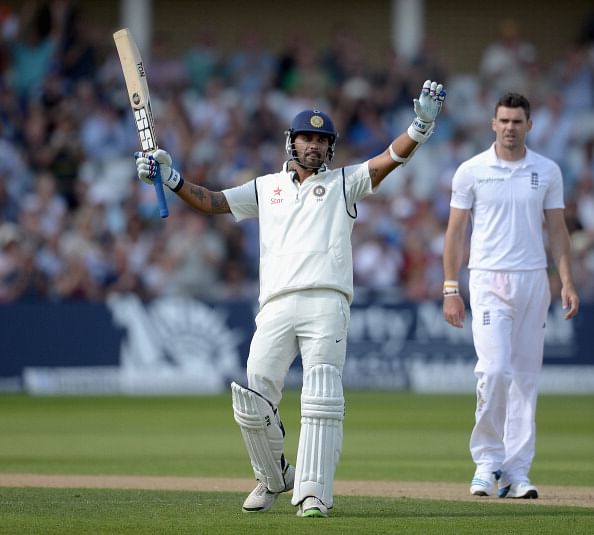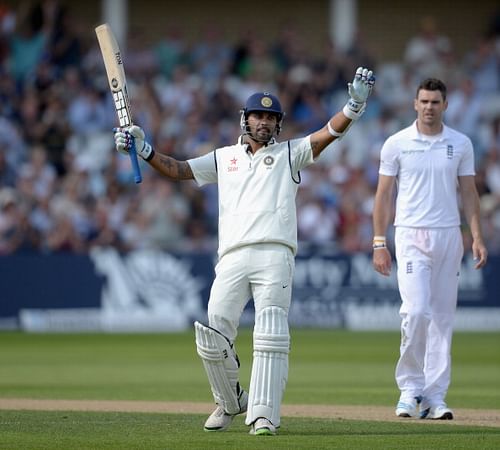
England v India 2014, 1st Test: What would be good first innings score on this pitch?
Team India have kicked off their tour of England on a decent note, and, going by the way the two sides battled it out in the middle yesterday, we could be in for a riveting contest over the course of this 5-match Test series.
This series is extremely different from the one in 2011, when India were atop of the ICC Test rankings table and England, with a terrific line-up that was chock-a-block with prolific run-getters, were knocking on the door to dethrone India from the No.1 spot in an attempt to claim the ICC Test championship for the first time.
That was in many ways a series that had far greater intensity right from the start. I have the feel, though, that we should see proceedings intensifying as this series progresses.

The Trent Bridge surface:
A brand new looking Indian outfit can be very proud of the way they have started the tour. Yes, the surface on offer is akin to a speeding highway that would never harm anyone riding their way through it, but, at the end of the day’s play, it was job well done by the visitors.
India’s selection policy, for once, was eccentric and innovative. Having finally come out of their shell of sticking with the theory of 7 batsmen and 4 bowlers for decades now, they decided to hand Stuart Binny his Test debut: a selection that might not quite reap the desired fruition due to the prevalent conditions at Trent Bridge.
Ravichandran Ashwin, due to his struggles in the previous overseas outings had to miss out from the playing XI, with Ravindra Jadeja continuing to get the captain’s preference. The hosts, on the other hand, wanted to strengthen the batting, leading to them taking the gamble of playing Ben Stokes, who’s primarily a batsman, ahead of Chris Jordan.
The surface, by the look of it, looked brown and bone dry. The reasoning behind preparing such a wicket for a high-profile Test series such as this one is that the pitch curator Steve Birks wants the Test match to last 5 days. Also, with the changes in drainage systems of most grounds in England recently, retaining the moisture for long enough on the surface has become a huge predicament.
Former England captain Michael Atherton, on air during his Sky Sports commentary stint, said that, after a battle between the 7 Test venues in the country to stage Test matches, the curator didn’t want to produce a wicket that would kill off the game in 3 to 3.5 days, something which would mitigate the respective venue’s chances of hosting a Test match in the future.
Day 1 review:
MS Dhoni, the Indian skipper, won the toss and chose to bat first. Team India and Murali Vijay got off the blocks quickly, and the boundaries, albeit streaky at times, were coming thick and fast. Shikhar Dhawan, at the other end, was his unusual self as he tried to bat his way through the initial period.
India were going along smoothly, and the talk of the pitch hardly rendering nothing to the hosts became a massive talking point. But James Anderson, as he so often does, came up with a delivery that held its line after pitching, and a sedate Dhawan, playing away from his body, edged it to Matt Prior, who dived to his left to take a brilliant catch.
Cheteshwar Pujara, joining Vijay in the middle, got off to a typical Pujara start. Anderson and Stuart Broad were by far the most threatening of the English medium-pacers. Stokes and Liam Plunkett could not pose the same threat as their senior counterparts managed to, and that was a major reason why the visitors weren’t all that uncomfortable. During the 1st session of the day, Indians were motoring along and reached 106/1 by lunch after 30 overs.
The post-lunch session, surprisingly, started off brightly for the hosts, as an innovative piece of captaincy from the oft-criticised Cook accounted for Pujara, who was caught at short mid-on trying to work the ball on the onside. Pujara departed for 38, but India were still in a very good position at 106/2 with Virat Kohli coming in.
Anderson and Broad were probing away right after the lunch break, and it was all happening. Lateral movement off the surface and in the air accounted for Kohli soon after the dismissal of Pujara. Kohli, too, playing away from his body was caught at 2nd slip for 1(8): a rare failure.
Ajinkya Rahane, coming in at No.5, had a massive role to play. Vijay was stranded on 55, playing within himself as he tried to see off the initial burst after lunch from the home team’s two premier fast bowlers. But, as like the morning session, the batsmen were able to accumulate the runs once Anderson and Broad went off the attack. The runs started to come from both ends for India as Mooen Ali was dispatched to all parts of the ground by batsmen. Vijay and Rahane remained unbeaten at Tea, and India reached 177/3.
Similar to the post-lunch session, which produced 2 quick wickets right after the resumption, the post-tea session produced the wicket of Rahane in the very first over. The 26-year-old, looking to pull a Plunkett-delivery from around the wicket, toed it off his bat to Cook at silly mid-off. India looked in trouble, and they needed their captain marvel Dhoni to see them through the turbulent period and steady the ship alongside Vijay.
Dhoni, looking to counter-attack, was prepared to look ugly in order to garner quick runs. The English bowlers, all of them, were tiring, which helped the batsmen breathe easy. Vijay brought up his 4th Test century but not before enduring agony and nervousness for a very brief period in his 90s. The 33-year-old Indian skipper was going along at a brisk rate of almost 80 runs per 100 balls and also kept talking to Vijay when the Tamilnadu batsman was feeling the pressure, especially when he was closing in on the landmark.
India finished with 259-4 at the of end day 1: a score that is pretty low for modern-day Test cricket, nevertheless a good start to the tour for the visitors. India have done well, but they have not pulled away from England, or ahead of the game itself. It will all unfold come day two of the Test match.
India’s First innings target:

All the talk before the series regarding the nature of the pitches in the country, and how the Indians were going to tackle it, seem to be redundant, at least for this Test match. It is arid, devoid of pace, and is insipid for a longer format game, truth be said. Looking at the scoreboard, you get the feeling that the visitors could have gone at a slightly brisk pace and ended somewhere close to 300 at stumps on day one.
As things stand, it looks like a surface that is going to get slower and slower as the Test match progresses; if that’s going to be the case, then India will need a lot more overs to bowl out England twice and force a result in their favor.
But, to start proceedings on day two, Dhoni and Vijay will have to score runs at a good clip and make sure that India reach 380-400 as early as they can. The surface, due to its abrasive nature, will assist reverse swing as the ball gets older and if the overhead conditions remain dry: something that should please the Indian bowlers.
Jadeja will be expected to play a key role in chipping away at the wickets and keeping the run flow down. I get the feeling that the surface might just dust up a bit if the sun is out for the next couple of days of the Test match, which will then come down to the Saurashtra tweaker to decide how this Test match pans out.
So, there you go: 380-400 is what India should be looking at when play resumes on Thursday. And the quicker they get to that total, the better their chances are at manipulating the pace of this Test match as they want to.
Day 2 should be intriguing to watch.